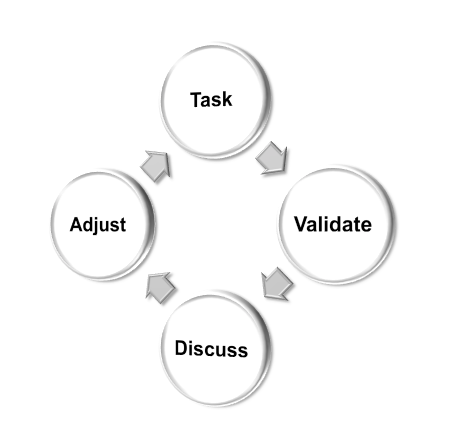
“Success on any major scale requires you to accept responsibility . . . . In the final analysis, the one quality that all successful people have is the ability to take on responsibility.” — Michael Korda
Responsibility is a powerful word and one that’s often times packed with a lot of emotion and unstated expectations. Throughout my career, I’ve come to realize that responsibility has different meanings depending on which point of view one holds and, more importantly, that These are important points and ones worth spending some time contemplating, right along with thinking about what type of leader you desire to be.
3 Key Points On Responsibility For Leaders To Know
Responsibility isn’t a state that people just arrive at. As a leader of people, this is really important point to understand. Never assume that the people reporting to you know how to accept, and then act with responsibility. It’s a skill that is built – or not – throughout life. Try to imagine a newly hired employee fresh out of college whose only responsibility before joining your firm was their course work and making class on time. Is this someone to whom you will hand responsibility for a critical path task on a high priority project? Not likely.
Thinking back to last month’s article on delegation, it may be worth the effort to evaluate your subordinates on their aptitude for responsibility using the same Hersey-Blanchard subordinate delegation maturity model. Understanding a person’s skill level and aptitude is an important data point for the leader wanting to ensure success for their project as well as success for their subordinate.
A second key point to consider about responsibility is how you define it for a given situation. Depending on which definition you use, you end up with a different set of skills required by the subordinate and a varying degree of risk. Here are three typical definitions of responsibility:
1. A duty or task that you are required or expected to do
2. The opportunity or ability to act independently and take decisions without authorization.
3. The state or fact of having a duty to deal with something or of having control over someone.
When you are conferring responsibility to a subordinate, are you doing so for a discrete task with a defined frame of action? Or more than that? Spending some time consciously unpacking what you mean by “responsibility” for each of your subordinates is important, lest you end up with undesired outcomes.
Which leads us to the third important key point to know about responsibility: it’s a learned skill. This is the most important key point, because it means that just because someone may not be responsible to your level of expectation today, doesn’t mean they cannot build the skill of becoming responsible to that level. It will take time, your direct involvement and understanding, and the subordinates motivation to move forward. However, responsibility, like leadership, can be learned and built upon.
Building Responsibility In Your Subordinates
Responsibility for tasks, actions or a job description can be assumed. But when that happens, you’re inviting risk to your organization’s mission, as well as to your reputation as a leader and your subordinates professional development and advancement. Amongst the various roles of leadership is the role of expectation-articulator-in-chief. Nothing eliminates guesswork and confusion more than clearly stated expectations.
The expectations you set for each of your subordinates must be aligned with their capacity and capability for responsibility. As previously stated, when you do this you greatly reduce risk to your organization’s ability to meet its mission or project. At the same time you’re assigning the right level of responsibility to the right person. Yielding too much responsibility to someone not ready to wield it can lead to all sorts of undesired outcomes ranging from project failure to you’re removal.
Take away: be conscious in your delegation of responsibility.
If you find yourself in a situation where you lack subordinates with right capacity and capability for responsibility, what do you do? Communicate with each person, develop an action plan, and consider these actions:
Start Small, Then Grow. There’s no better place to start in building a capability and capacity for any skill than to begin with small, easily achievable actions that build on each other. It’s the concept of small efforts and quick wins: start with something that the subordinate can tackle that has a high probability of their succeeding and allows them to build confidence. The resulting confidence they earn in leading, directing and being responsible for the action can guide them towards increasing levels of responsibility.
How do you do this? One way is to start with non-critical tasks that won’t derail a mission or project if they are performed substandardly. Another way is to have your subordinates take responsibility for professional or technical organization events and roles. From my own experience, this is a great avenue through which to build responsibility experience in a subordinate without jeopardizing your own organization. This concept is also one reason that, in the military, it’s custom to delegate to junior officer’s the responsibility for organizing visits by VIPs or extra duties such as ‘security officer’ or the Combined Federal Campaign. These seemingly benign activities allow the leader to assess the subordinates skills both leadership and responsibility as well as allowing the subordinate to build the same skills.
Train To Responsibility Needed. If there is a specific responsibility needed, for example the responsibility for a portion of a process or a specific role, then you can train your subordinate to execute just that activity set. The training must be formal or semi-formal with clearly stated expectations and desired deliverables. At a minimum, ensure you’ve thought through the procedures the subordinate must execute. Then, document and train. Is this a lot of work? Possibly, but the training and clearly stated expectations allow you both to have a clear framework around what must be done and what the subordinate will be responsible for.
Task, Validate, Discuss, Adjust (TVDA). Nothing is more enjoyable for a military engineer than a process and an acronym. Borrowing from the Plan-Do-Check-Act cycle for process improvement, the Task-Validate-Discuss-Adjust is a process you can use with your subordinates to build their capability and capacity for responsibility incrementally and with a clearly delineated governance process in place. In essence, once you task a subordinate with an action, you must validate the subordinates effectiveness in performing the task. Either during execution or afterwards, you can discuss performance and if necessary adjust activities before moving back into the tasking phase.
By following a cycle, you build in a procedure for continuous improvement for the subordinate and limit the risk to your organization achieving its mission or successfully completing a project.

Managing Responsibility With A Mature Team
If you’re operating with a mature team, then it can be very useful to create a responsibility assignment chart, or a RACI matrix. This is a project management tool used to identify the person on a project that is responsible, accountable, consulted and informed. It’s useful for clearly articulating roles and responsibilities and can help you take your high-performing team to the next level. Check out the download to learn more about the tool and how to apply it in your next project.
Reference:
A Guide to the Project Management Body of Knowledge: (PMBOK® Guide). Newtown Square, PA: PMI, 2013. Print.

